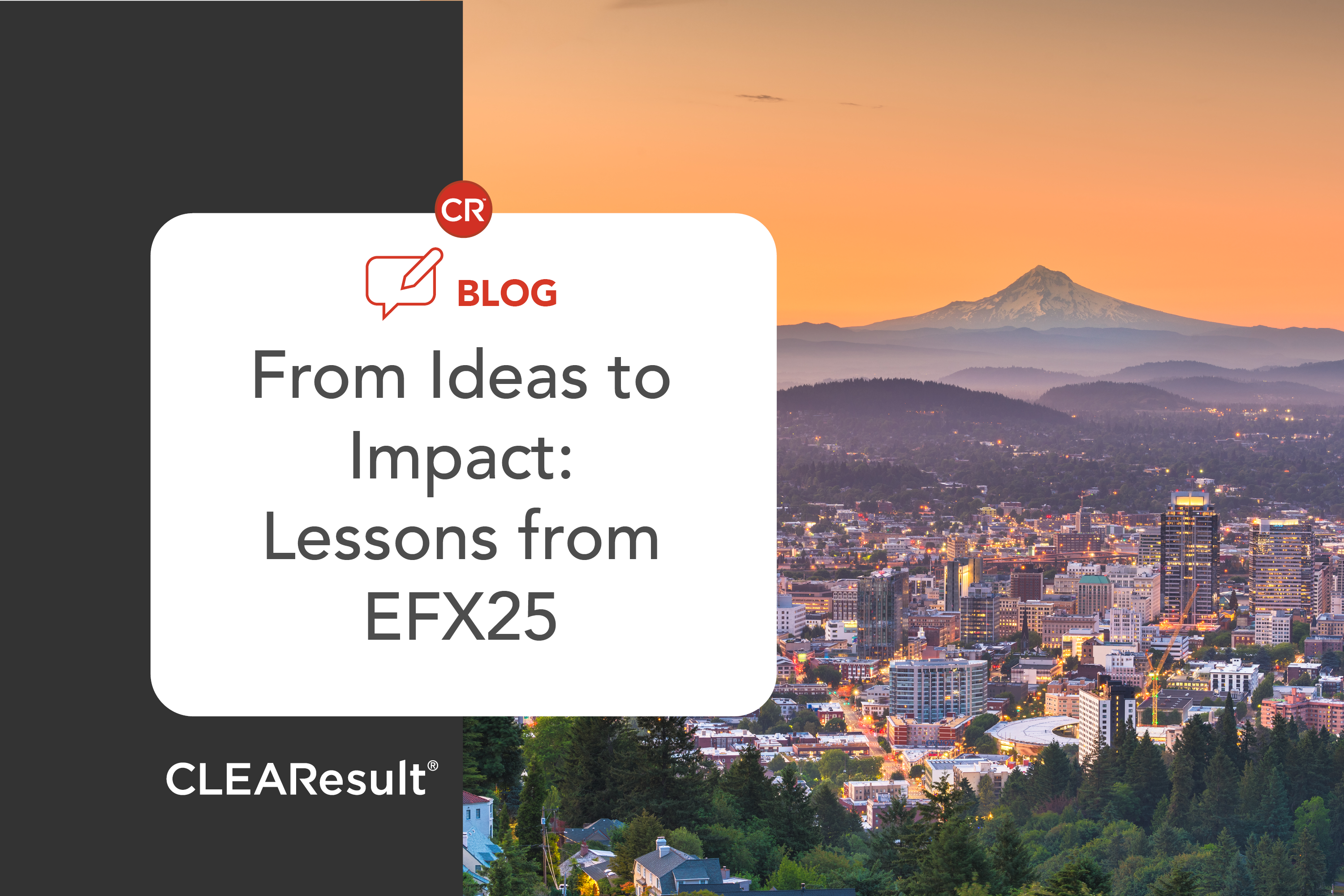From Ideas to Impact: Lessons from EFX25

The Northwest Energy Efficiency (NEEA) Efficiency Exchange 2025 (EFX25) conference brought together energy professionals from across the Pacific Northwest and beyond to explore the evolving landscape of energy efficiency, electrification and grid resilience. Held in Portland, the event offered a rich mix of insights, practical strategies and a shared call to think differently about how CLEAResult can lead transformational change in the communities we serve.
Leading with intention through change
Change was a unifying theme at EFX25. Keynote speaker April Rinne reminded us that while people typically embrace the change they choose, they often resist the change imposed on them. For the energy industry, the challenge is clear: we must frame change not as disruption, but as opportunity. From decarbonization to electrification, speakers encouraged conference attendees to let go of outdated assumptions. Whether it’s reimagining how we engage renters or prescribing insulation as a health intervention, the message was consistent: innovation begins with mindset.
Residential efficiency & equity
Residential energy efficiency programs continue to evolve, especially with heat pump water heaters (HPWHs) gaining momentum – particularly in rural markets where trust and word of mouth are key drivers of adoption. However, performance gaps persist due to improper electric resistance (ER) backup configurations. Solutions discussed included:
- Cold-climate HPWH models
- Limiting ER capacity
- Smarter controller logic
Many rural HPWH installations are DIY, underscoring the need for contractor training and visual, user-friendly tools. There’s also growing recognition that low-income and no-cost programs represent the next frontier for residential savings. But success depends on addressing cost barriers and investing in community-based trust, both cognitive (proven reliability) and emotional (shared experience). Strong relationships – with renters, customers, contractors and community-based organizations – are essential to long-term impact.
Grid flexibility & electrification
EFX25 highlighted a shift from traditional demand response (DR) to a more holistic approach centered on flexible load management. This emerging strategy delivers year-round grid benefits through dynamic, responsive control – this is especially important as winter peaks increase with widespread electrification of heating. Utilities are exploring:
- Dual-fuel HVAC systems
- Smart load shifting technologies
- Time-variable pricing
On the industrial side, electrification is gaining momentum, driven by corporate sustainability goals and ROI. Still, some skepticism remains around the cost-benefit of DR controls on HPWHs, which many manufacturers view as offering limited value relative to their complexity and cost.
Tools, programs & practical insights
EFX25 showcased a range of innovative approaches to program design, marketing and community engagement.
- CLEAResult’s small business program stood out for its advanced structure and implementation
- NEEA’s LLLC/HVAC integration pilot demonstrated a streamlined path toward grid-interactive efficient buildings
A clear takeaway: pilots matter. Testing new ideas – even those not yet cost-effective – can unlock scalable innovation.
On the program marketing front, the industry is starting to correct a long-standing oversight: treating outreach as secondary. Effective program messaging should:
- Compare home performance
- Highlight peer benchmarks
- Simplify the customer journey (especially in rural areas)
Collaboration was a consistent focus, particularly in how we engage with community-based organizations. These partnerships must be built on mutual respect, fair compensation and co-designed solutions that reflect the cultural, linguistic and geographic diversity of the communities served. Similarly, trade allies should be supported not just as businesses, but as trusted community members, with tailored, accessible resources and streamlined processes that empower them to succeed.
Looking ahead: AI, resilience & regional action
As the energy landscape evolves, AI is emerging as a force multiplier in building control systems – enabling real-time optimization, peak load forecasting and cost savings. But questions remain about data privacy, regulatory oversight and the balance between building- and utility-level control.
Meanwhile, new data highlights the resilience value of weatherization. Well-insulated homes maintain safe indoor temperatures during power outages – offering a compelling argument for integrating resilience into energy efficiency program design.
To meet the Pacific Northwest’s ambitious 2030 energy goals, the region must embrace:
- Dual-fuel HVAC strategies
- Coordinated distributed energy resource (DER) planning
- Collaborative large-scale electrification efforts that align utilities, communities and technologies
EFX25 proves that the future of energy isn’t just about tech – it’s about people, trust and transformation. As we navigate what’s next, let’s continue to think differently, collaborate deeply and embrace change with intention.